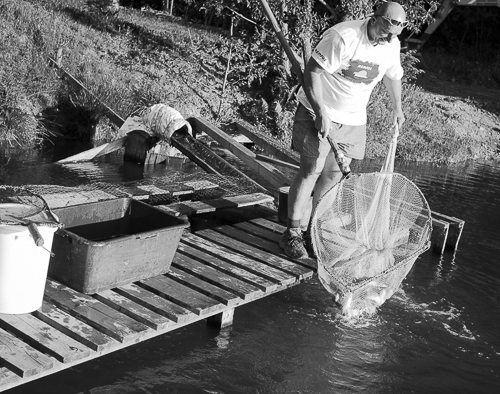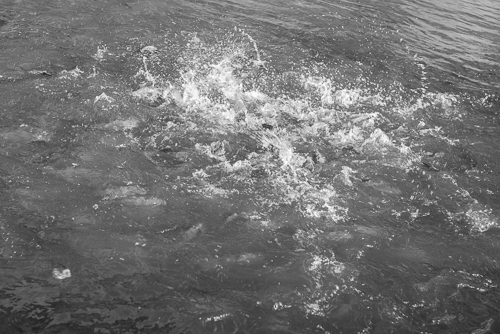Having almost passed the village of Mihăileni, we ascended above the village until we arrived at the fish farm of Filtermaiszter Zsolt. Of course, being a fish farm, an artificial lake caught our attention upon arrival. Having walked around the property, there were three more, each one located above the next one. According to the paper Small-scale rainbow trout farming this is a very good way of arranging a fish farm since it saves energy and consequently production costs. We could also see that oblique chutes in each lake brought air into the lakes, another feature recommended in the paper because trout requires a high level of oxygen in the water in which it lives.
Walking around the lakes, we had to pass meadows full of pretty wildflowers, but the lakes were also surrounded by deciduous trees and a beautiful mountain, on which we had hiked a few days before, was visible in the background. Having passed all the lakes, there was a brook just outside the property and the owner told my guide that he is diverting water from it.. The lakes also contained valves, which could be opened such that water would flow back to the brook in case of flood.
When he bought the property, it was covered by meadows and he had used a mechanical digger in order to excavate the artificial lakes whose maximum depth is 2.2 m. The maximum depth is very important in hot weather because trout needs cold water in order to survive and it tries to stay as deep as it can to avoid heat.
Mr Filtermaiszter had built a small hatchery near one of the lakes and he kept fertilised eggs and small fry in separate tanks. After about 3 months, he would transfer the fry to the uppermost lake, while he let the largest fish stay in the lowermost lake and fish of intermediate sizes in the two other lakes. In this way, the youngest and most vulnerable fish would get the cleanest water and big fish would be prevented from eating small ones.
As regards spawning, in-breeding has to be avoided and Mr Filtermaiszter looks at shape, fins and skin in order to verify that male and female fish, which are in general kept separately, are not related. He also buys fish eggs from other fish farms and he is a member of an association for fish farmers. Moreover, he has been interested in fish since he was 8 years old.
In the evening, he threw fistfuls of pellets into one lake at a time and we could watch the fish partly jump out of the water in order to catch the feed. Afterwards, he showed us a big house he was building for his guests. In fact, a company had built the frame of the house, while he was doing the interior work. In 2-3, years, the fish farm should be open for tourists who want to fish and prepare their own meals, He also wants to arrange hiking, driving and fishing trips, preparing mutton and pork, etc.
Mr Filtermaiszter has made his own workplace and is of course his own boss in a region with high unemployment. He’s selling to restaurants and he receives orders from customers. Slaughter of mature fish is done weekly.
He and his wife kindly served us freshly caught trout with beer and palinka for dinner, cooking the fish on a wood-fired oven. An excellent way of finishing an interesting visit.
Since the fish farm was located in the countryside, two young men were cutting hay on the property during our visit since dry hay is the prime feed of farm animals in winter in Romania. Actually, a flock of cows were grazing near the brook above the fish farm and we could hear their owners bring them home after sunset.
For those who want to catch their own trout instead, some advice can be found here.


